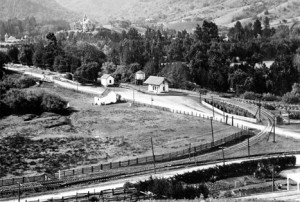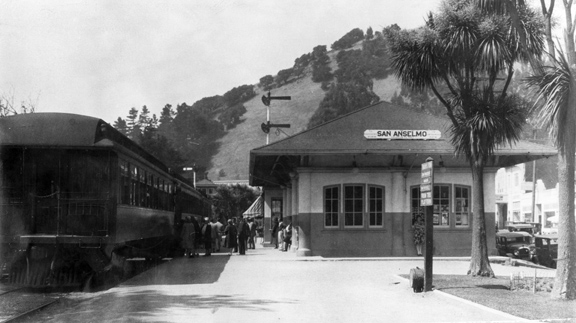
Zopf’s to the right of the road opposite the station.
In 1903, the old narrow-gauge railroad was replaced with the third-rail electric train, and the trip to San Anselmo from San Francisco, via ferry and rail, took a mere 55 minutes: Tourism had begun as San Franciscans poured into San Anselmo to exchange the summer fog for our warm, sunny climate. Bernard Brennfleck provided sylvan campsites alongside his orchard near Yolanda Station. Herman Zopf sold supplies from his grocery store at the Hub-and also allowed campers to use the faucet in back for their drinking water.
Life changed dramatically in 1906. The earthquake and fire drove people out of the City and into San Anselmo permanently. In town, the powerful quake toppled the tower of the Seminary’s Scott Hall.
In 1907, in an 83-to-79 vote, San Anselmo incorporated. While the narrow vote reflected debate on various issues, the most controversial was centered around liquor sales. Town residents, with the backing of the Seminary, had already succeeded in blocking applications for new liquor licenses. To get around the prohibition, “blind pig” establishments surreptitiously served drinks (euphemistically as “tea”) in back rooms to known patrons. Pro-incorporation advocates pushed for an officially “dry” town, where liquor could only be sold for medicinal or industrial uses. They won: Buying a drink in San Anselmo could land you 30 days in jail.
After incorporation, attention was focused on creating a true downtown center. In the early 1900s, San Anselmo’s central business district was located along the dusty county road we know as Sir Francis Drake, with some businesses clustered on Ross Avenue. The commercial focus shifted to San Anselmo Avenue in 1910, when James Tunstead donated land in his Linda Vista subdivision for a town hall. San Anselmo resident W. Garden Mitchell designed the town offices and the adjacent fire house, completed in 1911 at a cost of $5,291.

Town Hall & Library, c. 1920
The new mission-style train station was completed in 1911, and in 1914, San Anselmo received a $10,000 Carnegie grant for a library. Designed by Mitchell in the Spanish Revival style, it opened in 1915 where it stands today.


